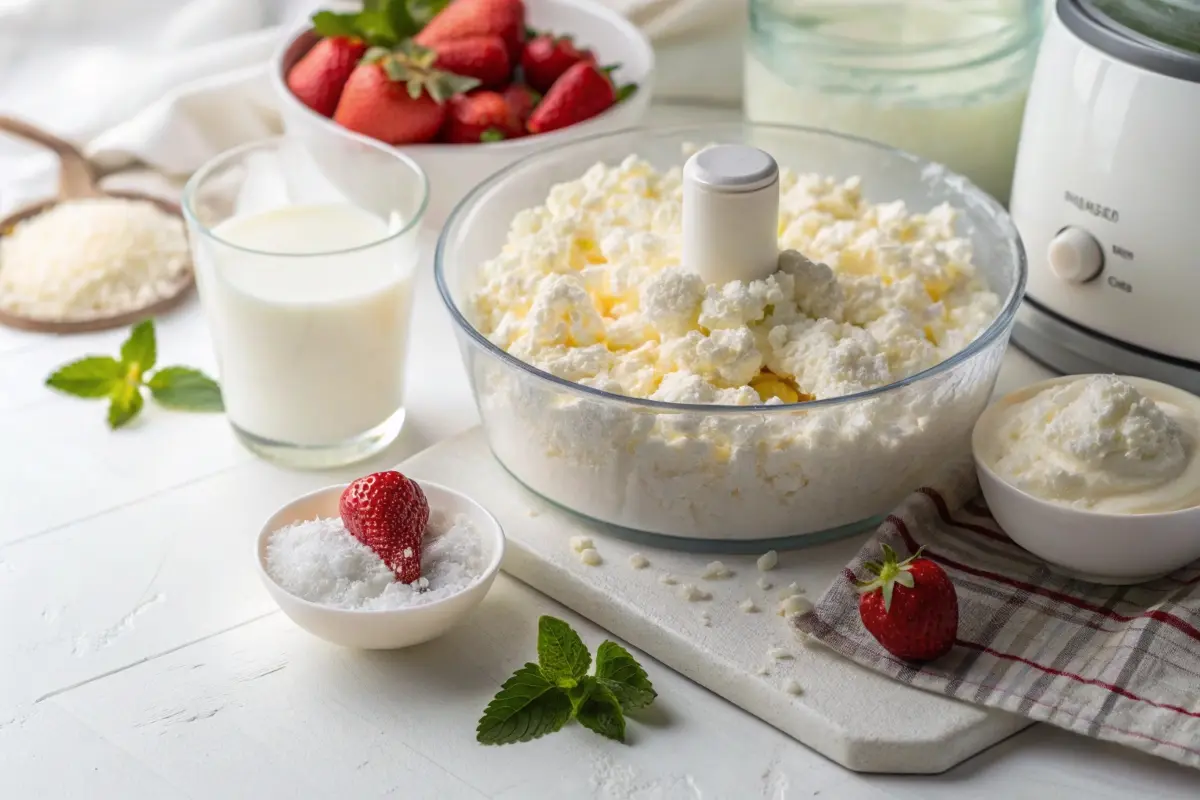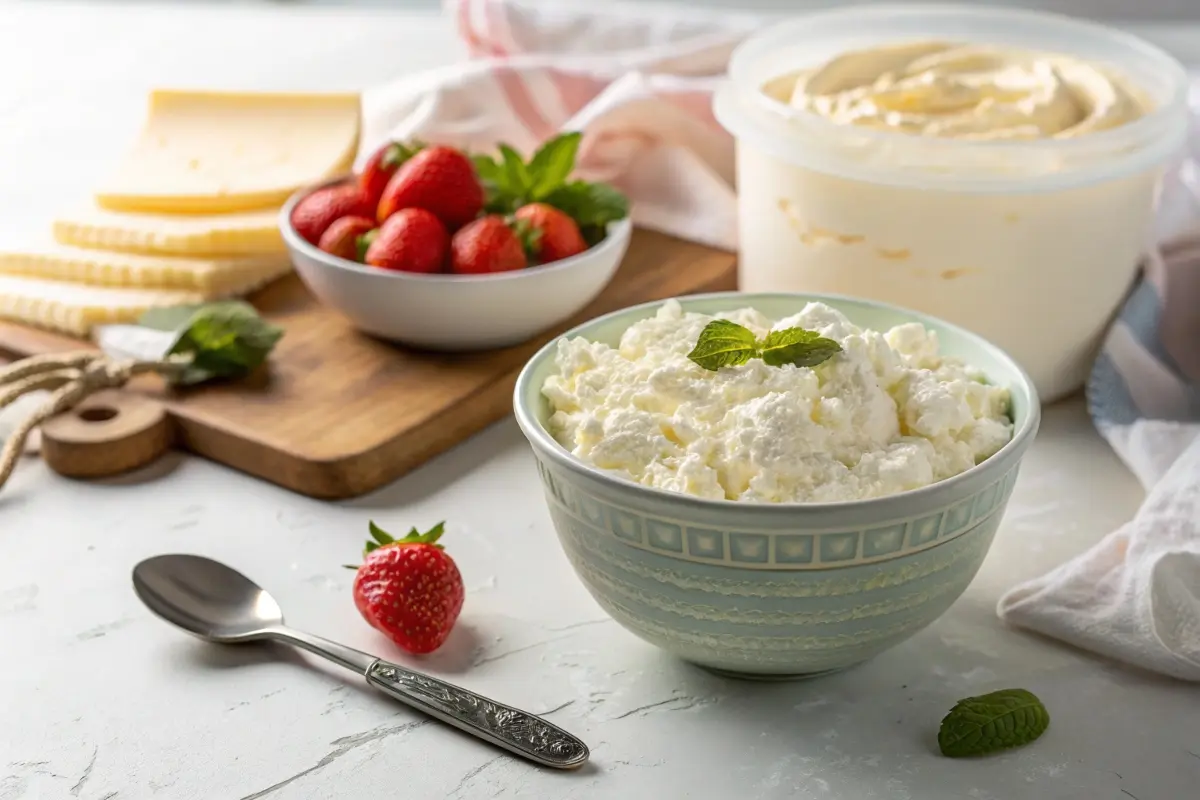Have you ever been in the middle of a recipe only to realize you’re out of cream cheese? Frustrating, right? Now, what if I told you there’s a workaround sitting right in your fridge? Yep, I’m talking about cottage cheese. But the big question is: can you blend cottage cheese to make cream cheese? Let’s dive into the world of these two cheeses and explore if this is a genius hack or a recipe disaster waiting to happen!
Table of contents
- Introduction to Cottage Cheese and Cream Cheese
- Can You Use Cottage Cheese as a Substitute for Cream Cheese?
- Blending Cottage Cheese to Mimic Cream Cheese Texture
- Common Problems When Blending Cottage Cheese
- Tips to Improve the Blending Process
- Recipes Using Blended Cottage Cheese as Cream Cheese
- Benefits of Using Cottage Cheese Over Cream Cheese
- Drawbacks of Using Cottage Cheese as a Cream Cheese Alternative
- Conclusion: Is Blending Cottage Cheese a Viable Solution?
- Frequently Asked Questions (FAQs)
Introduction to Cottage Cheese and Cream Cheese
Before we answer the main question, let’s take a step back and understand the stars of the show: cottage cheese and cream cheese. They may both be white and creamy, but they’re worlds apart in taste, texture, and even purpose. So, what’s the deal with these cheeses, and how are they different?
What Is Cottage Cheese?
Cottage cheese is that friendly cheese you often see in healthy recipes. It’s made by curdling milk with an acidic substance like vinegar or lemon juice. The result? Soft, lumpy curds swimming in a liquid called whey. It’s high in protein and a favorite for people looking to maintain a healthy diet. But, let’s be real—its texture can be an acquired taste!
“Cottage cheese is like the gym rat of the dairy world—lean, protein-packed, and ready to flex in your recipes.”
What Is Cream Cheese?
On the other hand, cream cheese is the indulgent cousin of cottage cheese. It’s smooth, rich, and spreads like butter on your morning bagel. Cream cheese is made by mixing cream with a small amount of milk and adding a coagulant. The result is a creamy, slightly tangy cheese that’s perfect for everything from frosting to dips.
The Key Differences Between Cottage Cheese and Cream Cheese
Let’s break down the major differences:
| Feature | Cottage Cheese | Cream Cheese |
|---|---|---|
| Texture | Chunky and lumpy | Smooth and creamy |
| Flavor | Mild and slightly tangy | Rich and tangy |
| Fat Content | Lower | Higher |
| Uses | Salads, snacks, healthy recipes | Spreads, desserts, baking |
Can You Use Cottage Cheese as a Substitute for Cream Cheese?
Now that you know the basics, let’s tackle the substitution question. Can you take a bowl of cottage cheese, blend it, and expect it to work like cream cheese? The short answer is: kind of. It depends on the recipe and your expectations.
Nutritional Comparison of Cottage Cheese and Cream Cheese
First, let’s look at the numbers. Cottage cheese is a healthier option compared to cream cheese, making it appealing for those looking to cut calories or up their protein intake.
| Nutrient | Cottage Cheese (1/2 cup) | Cream Cheese (1/2 cup) |
|---|---|---|
| Calories | 110 | 200 |
| Protein | 13g | 3g |
| Fat | 5g | 18g |
| Carbs | 4g | 2g |
When to Use Cottage Cheese as a Replacement for Cream Cheese
Blended cottage cheese works well in certain recipes, but not all. Here are some scenarios where it shines:
- In dips: Add herbs and spices, and you’ve got a healthier dip option.
- In pasta sauces: The creamy consistency works well here.
- In spreads: Blend it well, and it’s a decent substitute for your bagel topping.
But for something like cheesecake, the taste and texture differences might not make it the best swap.
Blending Cottage Cheese to Mimic Cream Cheese Texture
Here’s where the magic happens—or doesn’t, depending on your technique. Blending cottage cheese can transform it into a creamy consistency, but it takes a bit of finesse. Let’s explore the science and steps involved.
The Science Behind Blending Cottage Cheese
When you blend cottage cheese, you’re breaking down its curds and incorporating the whey. This creates a smoother texture, though it might still not be as silky as cream cheese. Adding other ingredients like a bit of milk or cream can help.

Steps to Blend Cottage Cheese into a Creamy Consistency
Follow these steps to get the best results:
- Choose full-fat cottage cheese: Low-fat versions tend to stay grainy.
- Add liquid: A splash of milk or cream goes a long way in achieving smoothness.
- Blend well: Use a high-speed blender or food processor for at least 2–3 minutes.
- Check the consistency: Stop and scrape down the sides to ensure everything is evenly blended.
Tools Needed for Blending Cottage Cheese
You’ll need a reliable blender or food processor. A hand blender can work in a pinch, but it might take longer to get a smooth texture. Pro tip: chill the cottage cheese beforehand for better blending.
Common Problems When Blending Cottage Cheese
Okay, so you’re ready to turn your cottage cheese into a cream cheese substitute. You throw it in the blender, and… it’s still grainy! Or maybe it tastes nothing like the cream cheese you love. Don’t worry; you’re not alone. Let’s look at some common problems people face when blending cottage cheese and how to fix them.
- Grainy Texture After Blending
One of the most common issues is ending up with a texture that’s still a bit lumpy. This happens because the curds in cottage cheese can be stubborn and don’t break down easily.
“Think of it like trying to smooth out gravel into sand—it takes effort, and the right tools!”
Solution: Use a high-speed blender or food processor and blend for longer than you think is necessary. Adding a little cream or milk can help loosen the curds and create a smoother consistency.
- Lack of Flavor Similarity to Cream Cheese
Even when you get the texture right, the taste might not hit the mark. Cottage cheese has a milder flavor compared to the tangy richness of cream cheese.
Solution: Add flavor enhancers like a pinch of salt, a squeeze of lemon juice, or even a bit of Greek yogurt. These ingredients can mimic the tanginess of cream cheese.
- Difficulty in Achieving a Smooth Consistency
Sometimes, no matter what you do, your cottage cheese just won’t cooperate. This can be due to the type of cottage cheese you’re using.
Solution: Opt for full-fat or small-curd cottage cheese. These types are easier to blend and result in a creamier texture. Avoid low-fat or large-curd varieties unless you’re okay with a little extra effort.
Tips to Improve the Blending Process
If you’re still struggling, don’t give up just yet! These tips can help you get the most out of your cottage cheese blending experiment.
Choosing the Right Type of Cottage Cheese
The type of cottage cheese you start with makes a huge difference. Full-fat cottage cheese blends better because it has more natural creaminess. If you’re using low-fat or fat-free versions, you might need to add extra ingredients like cream or olive oil to compensate.
Adding Additional Ingredients for Better Texture and Flavor
Here are a few simple additions that can elevate your blended cottage cheese:
- Milk or cream: For a smoother texture.
- Greek yogurt: Adds a tangy flavor similar to cream cheese.
- Butter: Helps replicate the richness of cream cheese.
- Seasonings: Salt, garlic powder, or fresh herbs can add depth of flavor.
“Blending cottage cheese is like dressing up a plain outfit—you need the right accessories to make it shine!”
How Long to Blend for Optimal Results
Patience is key. Blend your cottage cheese for at least 2–3 minutes, pausing occasionally to scrape down the sides of the blender. If it still isn’t smooth, keep blending until you achieve the desired consistency.
Recipes Using Blended Cottage Cheese as Cream Cheese
Once you’ve mastered the art of blending cottage cheese, you’ll find that it can be used in a variety of recipes. Here are some delicious ideas to try out:
Homemade Cheesecake with Blended Cottage Cheese
Cheesecake made with blended cottage cheese is not only lighter but also packed with protein. Here’s a quick recipe:
| Ingredient | Quantity |
|---|---|
| Blended cottage cheese | 2 cups |
| Eggs | 3 large |
| Sugar | 1 cup |
| Vanilla extract | 1 tsp |
| Crushed graham crackers | 2 cups |
| Butter (melted) | 1/2 cup |
Blend the cottage cheese, eggs, sugar, and vanilla until smooth. Pour the mixture over a graham cracker crust (made by combining the crackers and butter) and bake at 350°F (175°C) for 45 minutes. Let it cool, and you’ve got a creamy, guilt-free dessert!
Creamy Pasta Sauce Using Cottage Cheese
Blended cottage cheese can be a game-changer in pasta sauces. Simply blend it with garlic, olive oil, and a bit of parmesan cheese for a creamy, protein-packed sauce that pairs beautifully with your favorite pasta.
Blended Cottage Cheese as a Bagel Spread
Miss your cream cheese on bagels? Blended cottage cheese is an excellent alternative. Add some chopped chives, a pinch of salt, and a squeeze of lemon for a tangy spread that’ll make you forget it’s not the real deal.
Benefits of Using Cottage Cheese Over Cream Cheese
Now that you know how to transform cottage cheese into a cream cheese substitute, let’s talk about why you’d want to do this in the first place. There are some compelling benefits to using cottage cheese over traditional cream cheese, especially if you’re health-conscious or just curious about trying something new.
Lower Calorie and Fat Content
If you’re watching your calorie intake, cottage cheese is a clear winner. Compared to cream cheese, it’s significantly lower in calories and fat while still offering a creamy texture when blended.
“Think of it as swapping out a double cheeseburger for a grilled chicken sandwich—still satisfying but way lighter!”
For example, a half-cup of cream cheese contains about 200 calories and 18 grams of fat, whereas the same amount of cottage cheese has only 110 calories and 5 grams of fat.
High Protein Content for Health-Conscious Consumers
One of the standout benefits of cottage cheese is its protein content. A half-cup serving packs a whopping 13 grams of protein, making it a fantastic choice for anyone trying to boost their protein intake. Cream cheese, in comparison, only offers about 3 grams of protein per serving.
Versatility in Recipes
While cream cheese has its place, blended cottage cheese can be used in various recipes, from dips and spreads to creamy sauces and desserts. Plus, its neutral flavor means it can easily adapt to both savory and sweet dishes.

Drawbacks of Using Cottage Cheese as a Cream Cheese Alternative
Of course, no substitute is perfect. While cottage cheese has its perks, it’s not without a few drawbacks when used as a stand-in for cream cheese.
Differences in Taste and Texture
Even when blended, cottage cheese doesn’t have the same rich, tangy flavor that cream cheese is known for. If you’re a purist when it comes to cheesecake or bagel spreads, you might find the taste lacking.
Limited Applicability in Certain Recipes
Some recipes, especially baked goods like frosting or dense cheesecakes, rely on the fat content and specific texture of cream cheese. While blended cottage cheese can work in a pinch, the results may not be quite the same.
“It’s like using a tennis racket to play badminton—it works, but it’s not ideal.”
Conclusion: Is Blending Cottage Cheese a Viable Solution?
So, can you blend cottage cheese to make cream cheese? Absolutely, but with some caveats. While it won’t perfectly replicate the rich, tangy flavor of cream cheese, it’s a fantastic alternative for certain recipes, especially if you want to cut calories or increase your protein intake.
“Blended cottage cheese isn’t a magic wand, but it’s a versatile tool in your culinary toolbox.”
If you’re willing to experiment and tweak your recipes, you might just find that blended cottage cheese earns a permanent spot in your kitchen. Give it a try and see for yourself!
Frequently Asked Questions (FAQs)
Still, have questions about blending cottage cheese into cream cheese? Let’s clear up a few common queries.
What are common mistakes when making mousse?
- Overwhipping cream or egg whites: This can result in a grainy texture instead of a smooth, airy mousse.
- Improper folding technique: Being too rough can deflate the whipped components, ruining the mousse’s light texture.
- Skipping chilling time: Mousse needs time in the fridge to set properly; rushing this step leads to a runny dessert.
Is blended cottage cheese the same as sour cream?
No, blended cottage cheese and sour cream are not the same. While blended cottage cheese can achieve a smooth texture, it lacks the tangy flavor and creaminess of sour cream. However, it can be used as a healthier substitute in certain recipes with a few tweaks, like adding lemon juice for tanginess.
What’s the difference between chocolate pudding and chocolate mousse?
- Texture: Chocolate pudding is thicker and denser, while chocolate mousse is light and airy due to whipped cream or egg whites.
- Ingredients: Pudding uses cornstarch or flour as a thickener, whereas mousse relies on whipped ingredients for volume.
- Preparation: Pudding is typically cooked and chilled, while mousse is prepared with minimal cooking, focusing on whipping and folding techniques.
Can Blended Cottage Cheese Replace Cream Cheese in All Recipes?
Not quite. While it works well in dips, spreads, and some sauces, it’s not a perfect replacement for cream cheese in recipes that require a specific fat content or flavor profile, like classic cheesecake or frosting.
What Are the Best Brands of Cottage Cheese for Blending?
Look for full-fat or small-curd cottage cheese for the best results. Brands that are known for their creamy texture, such as Daisy or Breakstone’s, tend to blend more smoothly than lower-quality options.
How to Store Blended Cottage Cheese?
Once blended, store your cottage cheese in an airtight container in the refrigerator. It’s best to use it within 3–4 days for optimal freshness. If it separates slightly, just give it a quick stir before using.
